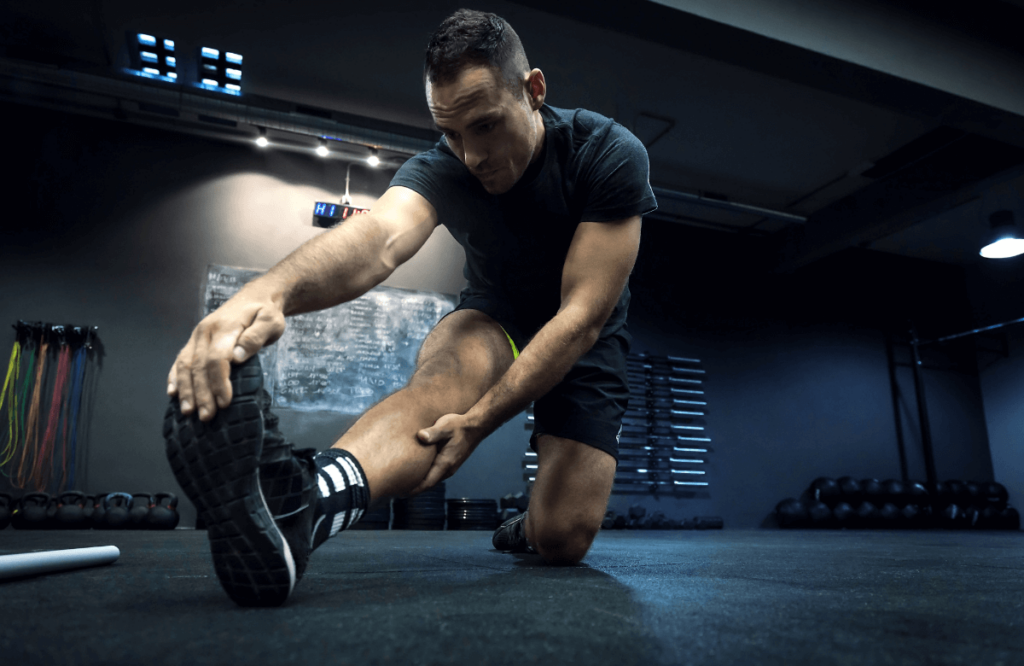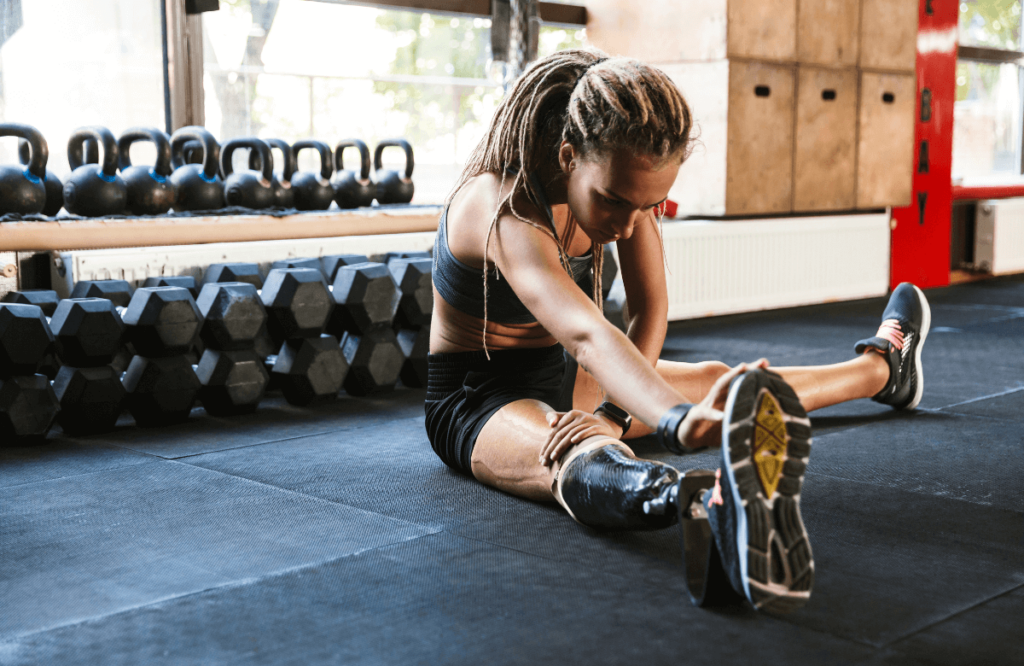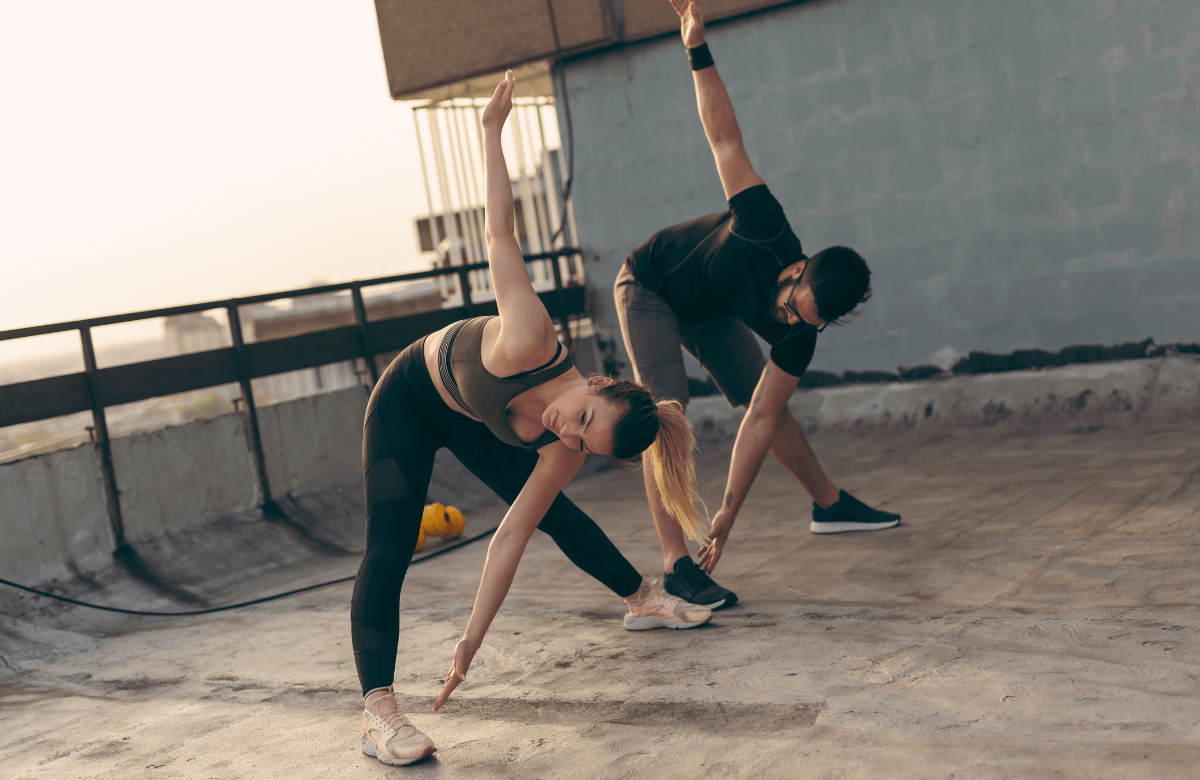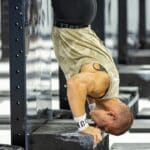For many years, there’s been a debate about whether or not you should stretch when trying to build muscle. Many have believed that stretching can cause stretch-induced hypertrophy and put you at a disadvantage for muscle hypertrophy.
However, more recent research has shown that stretching can have positive effects on your gains In muscle mass. A muscle growth study published in the Journal of Applied Physiology discovered that those who stretched after they worked out a specific muscle group could see a 318 percent growth within four weeks.
But does stretching build muscle? Let’s examine the truth of this study and how you can use stretching to your advantage.
Jump to:
- How Does Stretching Build Muscle?
- How to Stretch the Right Way
- Why Stretching Is So Important for Muscle Growth?
- Is It True That Stretching Hurts Muscle Gain?
- Can Stretching Between Sets Build Muscle?
- Can You Avoid Muscle Soreness By Stretching?
- A Few of the Best Muscle-Building Stretches
- Does Stretching Build Muscle? FAQ
How Does Stretching Build Muscle?
You know when you get a pair of jeans out of the dryer, and they’re stiff and tight when you first put them on? But as you move and stretch throughout the day, they loosen up and you suddenly have more room to breathe.
Stretching to help build muscle works similarly. As you stretch, the thin casing of tissue that encompasses your muscles, also called fascia, expands. Without stretching, this casing can remain stiff and strict, limiting your muscle fibers.
Based on our testing, this is the best creatine for most people. It has the perfect dosage of creatine monohydrate per serving, which has been proven to increase muscle mass.
- Promote strength and muscle gains
- Tested for purity and safety
- Creatine has no known side effects
With the fascia’s tight hold released, your muscles will not only feel less sore after a good workout, but they’ll also have more room to grow.

How to Stretch the Right Way
The correct way to stretch offers a balance of stretching to release tension without stretching too far and pulling a muscle. You should feel muscle tension, so it won’t be completely comfortable, but it shouldn’t hurt. If you’re overstretching, you’ll be in pain, and it can cause muscle damage.
Basic dynamic stretches engage or pull on a single muscle enough that you feel the connective muscle tissue stretching and pulling. Focus on breathing normally to ensure you’re not tensing up as you stretch, and hold it for 20-30 seconds. If you’re particularly sore or tense in an area, feel free to hold it longer.
Release, and shake out that muscle as a last effort to prevent unwanted tension in your muscle groups.
A Few Tips for Stretching Success
As you start your stretches, here are a few tips for success:
- Avoid passive stretching when your muscles are cold, which puts them at a higher risk of injury. Enjoy a light warmup like walking or jumping jacks to loosen the muscles before you stretch.
- Don’t bounce as you stretch, which could pull a muscle or even cause more muscle tension.
- Stretch both sides of your muscles equally. If you’re stretching your calf muscles, for example, you’ll hold the stretch in one calf for the same amount of time as the other. Failing to maintain this symmetry can cause one side of your body to overcompensate, potentially resulting in injury.
- Focus on the muscle groups you’ll be using for your workout. For example, if it’s leg day, stretch leg muscles including quads, calves, hamstrings, etc.
- Enjoy a few stretching sessions per week for muscle strength. This is a great intervention tool often used in sports med to reduce your injury risk and prevent muscle atrophy.

Why Stretching Is So Important for Muscle Growth?
There are many benefits to stretching for muscle length and hypertrophy, and it all boils down to the fact that stretching is healthy. It keeps muscles flexible, healthy, and strong. It gives you a greater range of motion to perform your movements and helps to prevent injury.
As mentioned previously, it also expands the connective tissue around your muscles, allowing those protein fibers to grow and expand. Without restriction, this intervention could cause increases in muscle thickness and therefore strength.
The Benefits of Stretching for Muscle Gains
Regular stretching routines really can make a difference in your muscle growth. Let’s highlight a few key benefits of stretching to increase muscle mass.
Increase Your Max: Some research indicates that you can increase your max repetitions by at least one if you’ve stretched first. It can be a fantastic tool for athletic performance.
Flexibility: As you increase flexibility throughout your body, your range of motion results and performance improves. You might also call flexibility range of motion training. Flexibility improves dynamic strength, reducing injury risk and causing an increase in muscle mass.
Aid in Repair: With lactic acid buildup in the tiny tears of your muscles, you need good circulation for muscle repair. That’s where stretching comes in, to improve circulation and promote muscle hypertrophy in humans.
Reduce Soreness: Stretching also helps to release lactic acid buildup, so you feel less sore after your workout. If you’re struggling to get back to the gym because of sore muscles, stretching to relieve that mechanical tension can indirectly promote strength because it gets you back to the gym.
Prevent Injuries: No one wants to hamper their gains by injuring a muscle. Stretching releases tension and helps to improve performance without injury.
Results Take Time
Stretching is a tedious process before and after your workout, so it’s tempting to skip it. Especially if you don’t see positive effects immediately. While you’ll likely feel a little better with a good stretch, you might not see growth as quickly.
Remember that you won’t see results overnight. Give it at least a month before you judge for yourself if stretching works for gains.
Based on our testing, this is the best creatine for most people. It has the perfect dosage of creatine monohydrate per serving, which has been proven to increase muscle mass.
- Promote strength and muscle gains
- Tested for purity and safety
- Creatine has no known side effects

Is It True That Stretching Hurts Muscle Gain?
There’s been a rumor going around that stretching before and during strength training could have negative effects. A 2008 muscle growth study from the University of Nevada, Las Vegas published findings stating that stretching before or after your workout could cause muscle atrophy. Since that was published, athletes everywhere stopped stretching before their workouts.
However, this research has not withstood the test of time. While research continues to support the notion that stretching can somewhat weaken performance in competition, it no longer shows that it will put the brakes on muscle growth.
In fact, current research indicates that you can see an improvement in muscle thickness by over 300 percent with simple muscle stretching. And previous studies show there are many habituation effects of stretching.
Can Stretching Between Sets Build Muscle?
Interset stretching, or stretching between sets, can help you build muscle according to a study published in PubMed.gov. In the study, those who performed passive, static stretches for 20-30 seconds between sets saw more muscle growth than those who did nothing.
Can You Avoid Muscle Soreness By Stretching?
You might not be able to avoid muscle soreness with stretching, but it can help. If you stretch before and after your workout, it helps to release tension that will make you sore later. In cases of mild soreness, stretching out the muscles can help to relieve minor aches.
Pay special attention to your hip flexors, skeletal muscles, extended knee joint, plantar flexors, and other areas of your body that tend to get very tight. This type of intervention will have excellent workout interaction effects.
However, you shouldn’t stretch with acute muscle soreness, as the tension may be so tight you could pull a muscle. Stick to other forms of pain relief in these cases, and try to loosen the muscles by walking.

A Few of the Best Muscle-Building Stretches
As you seek gains in your muscle mass, let’s look at some of the stretches that could help you see the most effective results.
Bicep Stretch
One of the easiest ways to stretch your biceps is to clasp your hands behind your back and with your arms straight, raise your arms until you feel the pull in your biceps, chest, and shoulders.
You can also stand with your hand flat on the wall and your elbow at a 90-degree angle. With your hand firmly placed, turn your body away from the wall until you feel the stretch in your upper arm.
Calf Stretch
Find a wall and put your toes on the wall with the back of your heel resting on the floor. Stand straight up and lean towards the wall until you feel it in your calves.
You can also do the yoga pose downward facing dog with your feet and hands flat on the floor and your rear end raised to the sky. You’ll push back on your heels to stretch your calves and hamstrings.
Chest and Shoulder Stretch
The bicep stretches we mentioned earlier will also stretch your chest, but we have a couple of other suggestions too. Sit on the ground with bent knee joints and feet flat on the floor. Put your hands flat behind you and push your chest upward until you feel the stretch in your chest, shoulder, and biceps.
You can also stand up holding a bar behind your head. Your hands should be shoulder-width apart as you push the bar backward until you feel the chest stretch.
An even simpler chest stretch involves spreading your arms straight out. Your palms should face forward as you push your arms back.
Hamstring Stretch
Stretching your hamstrings is an excellent intervention leg move. It’s highly advantageous for both cardio and strength training, and there are a few ways to accomplish the job.
We love the hammy stretch where you stand upright and put one leg forward. The back of the heel should rest on the ground with the toes pointed upward. Lean forward until you feel the stretch in the back of your leg. It’s so simple, yet the effects of doing this stretch several days per week can be extremely beneficial.
You can also do this stretch with the static leg kneeling down and the stretching leg in front of you. You’ll lean forward and place your hands on the floor on either side of your leg.
Quads Stretch
This one is easy. Simply grab your foot and pull it up behind you until it rests on your glutes. Continue pulling on the foot until you feel the stretch in your quads.
If you’re not very flexible, your foot might not be able to reach your glutes, and that’s okay. Just pull until you feel the stretch.
Additionally, avoid pulling your legs out to the side of you, as that can cause an over-extended knee joint. It’s okay to rest your hand on a table or against the wall if you struggle with balance.
Triceps Stretch
Lift your arm into a weightless bicep curl without tilting your wrists. Keep your arm in this position as you raise the arm above your head. Your upper arm should rest near your ear with your hand falling behind your head. Use the other arm to reach up and press down on the bent elbow to engage the tricep.
Lower Back Stretch
Child’s pose is a popular lower back stretch in which you kneel on the floor with your knees separated and pointing out slightly. Then, lean forward until your forehead touches the ground. Stretch your hands above your head on the floor until you feel that stretch throughout your back.
You could also try a seated twist stretch in which you sit on the ground with one leg straight out in front of you. Cross the other over your extended leg and place the foot flat on the ground. Extend the opposite arm on the outside of the crossed-over leg.
As you twist your body away from your crossed leg, use your elbow to push against the knee and feel the stretch in your lower back and glutes.
Hip Circle Stretch
Open up your core and legs with a good hip circle. You’ll stand straight with your feet hip-width apart. Place your hands on your hip and begin moving your hips in a circle as if you’re balancing a very slow-moving hula hoop. Push your hips forward, around, behind you, and forward again. Do this for 20-30 seconds and then switch direction.
Does Stretching Build Muscle? FAQ
We want to make sure we’ve answered every question you might have about stretching for muscle gains, so let’s look at some questions we often see on this subject.
How Long Does It Take to See Results from Stretching?
If you’re looking for results in flexibility, range of motion, and performance, expect to see results within two to four weeks, given that you’re stretching at least five times per week. It will take longer if you only stretch a couple of times per week.
If you want to see muscle gains from stretching, give it at least a month. You should be stretching every time you work out and holding the stretch for at least 30 seconds.
For even faster results, consider trying a one-hour stretching intervention on or two days per week. These extra intervention sessions can increase your flexibility and performance on many different levels.
Can You Get Ripped from Stretching?
Unfortunately, stretching alone won’t get you ripped. In combination with other movements, however, you can build muscle. So incorporating stretching into your workout can loosen tight muscles so that you can push them harder. Stretching is a common sports med tool to help prep your body to push harder in future workouts.
It can also release tension around protein fibers and increase blood flow to aid in muscle repair and boost growth. So you can get ripped just a little faster if you’re incorporating muscle stretching into your strength training.
Does Stretching Shape Your Body?
There are many body composition advantages of stretching. Limber muscles will not only look leaner, but they’ll also help improve your posture. If you’re someone who’s developed a bit of a hunch when they work over a computer, that can translate into a slouched posture even when you’re not at work. Stretching loosens those muscles tightened from hours of bad posture to help you naturally stand straighter and look leaner.
And if you’re stretching alongside strength training, your gains will become more apparent with time. You might see gains in muscle size a little more quickly with stretching on your side.

Are Stretching Gains Permanent?
Unfortunately, the gains and flexibility you achieve from stretching won’t last without maintenance. However, if you stretch for months when you work out and then stop for a couple of months, your body will have an easier time bouncing back to your stretching and muscle gains routine than if you never stretched.
What Happens If I Stretch Every Day?
For your muscle growth, stretching every day will aid in muscle repair and performance. You’ll see gains and enjoy a more limber body as a result.
There are more benefits of stretching besides muscle gains. Here are a few key benefits you’ll encounter if you stretch daily:
– Reduced soreness
– More flexibility
– Better performance in athletics
– Increased range of motion
– Better blood flow to muscles
– Improved posture
– Less back and joint pain
– Stress relief
– Fewer tension headaches
Are There Disadvantages to Stretching?
If you’re not stretching properly, you’re at a higher risk of pulling a muscle and causing injury. Nothing puts the brakes on muscle growth like an injury! Failing to warm up before you stretch is the most common cause of injury when stretching.
There’s also some research to suggest that muscle stretching before a competitive sport can decrease your performance. This doesn’t apply to everyday working out, but it’s something to consider.
But when it comes to trying to grow muscle in humans, there are no proven disadvantages to stretching. It can be a more effective way to grow your muscles and improve strength.
How Do I Know If Stretching Works for Me?
To determine if dynamic stretching Improves your gains, you’ll want effective measures of muscle growth. Take notes on your measurements and the effects of your performance after stretching. You might pay attention to how your range of motion improves, your flexibility, muscle lengths, or other simple measurements. Certain orthotic devices can help you track your measures of muscle growth.
You could also attempt a simple muscle growth study on your own body. You might label one leg as your control leg and the other as the test subject. Perform the same exercises on both legs, but only stretch the test subject leg. Leave the control leg alone. You’ll want to spend at least 4 weeks of consistent workouts on this study to get accurate results.
Using your own devices to track gains in muscle size, you can note whether or not stretching makes a difference for you. If you notice an improvement in muscle thickness on the test subject size, you’ll know stretching works to improve muscle gains.














